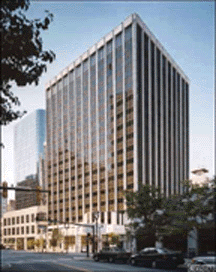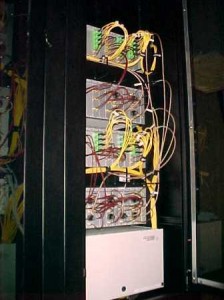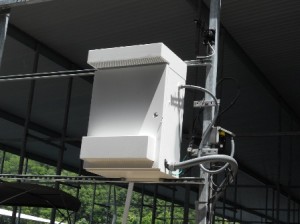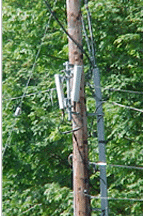Indoor Private and Public Area Wireless – DAS (Distributed Antenna System)
In many buildings and structures, there may be multiple wireless services
that  are highly desired, but which cannot penetrate into the structure. An indoor DAS (Distributed Antenna System) is designed and installed to solve this situation. The distribution portion of a DAS can be implemented with coax or fiber systems, or a combination. Larger venues, and those DAS’s carrying a higher number of wireless services, are best served with the wide bandwidth of a fiber system. However, coax distribution remains a viable and highly cosst-effective solution for some system configurations.
are highly desired, but which cannot penetrate into the structure. An indoor DAS (Distributed Antenna System) is designed and installed to solve this situation. The distribution portion of a DAS can be implemented with coax or fiber systems, or a combination. Larger venues, and those DAS’s carrying a higher number of wireless services, are best served with the wide bandwidth of a fiber system. However, coax distribution remains a viable and highly cosst-effective solution for some system configurations.
Typical sites are malls and large stores, stadiums and arenas, office buildings, government buildings, museums, traffic tunnels, casinos, dormitory and apartment complexes, hotels, and buildings with significant public use, such as hospitals.
Indoor Business-to-business Wireless
 Businesses often consolidate their wireless services with one wireless operator. Taking maximum advantage of that consolidated service sometimes requires wireless service extension into the business’s indoor facilities. But as in any good business-to-business relationship, the requirements of all parties must be met. We work with or through the wireless operators, and with the business concern, to implement an indoor system to meet the needs of the business while meeting the technology and performance requirement of the wireless operator.
Businesses often consolidate their wireless services with one wireless operator. Taking maximum advantage of that consolidated service sometimes requires wireless service extension into the business’s indoor facilities. But as in any good business-to-business relationship, the requirements of all parties must be met. We work with or through the wireless operators, and with the business concern, to implement an indoor system to meet the needs of the business while meeting the technology and performance requirement of the wireless operator.
Typical sites are business office buildings, factories, warehousing facilities, power plants, construction and engineering offices, and hospitals.
WiFi – Wireless LAN
This is the ubiquitous, unlicensed technology in both the business space and the public space, used for direct access to the world-wide-web for so many applications. DAS systems can implement WiFi (802.11) technology as an added service or spectrum band(s). One of the key considerations is the capacity needs for the WiFi system versus the cellular or public safety system. User capacity in the 2 system types (WiFi vs cellular/2-way) is implemented in entirely different fashionss.Modern DAS architectures are compatible with low to moderate capacity WiFi systems. However, in a public space or larger business environment, the WiFi system capacity will be heavily challenged. Any high capacity WiFi situation usually demands a separate WiFi solution. Please see our page for “WiFi over DAS” to understand the pros and cons of merged WiFi and cellular DAS systems.
WiFi applications are mostly limited to indoor uses, and can be put in any public or private use space requiring access to the World Wide Web (Internet).
Outdoor Optical Systems
 These systems are specialized wireless transport and distribution systems for outdoor use, and are sometimes known as “outdoor DAS”. They become essential in areas where the visual impact of a tower is undesirable for community aesthetics. These systems can also provide an effective method of distributing system capacity in high-traffic urban settings, or for signal transport to building tops to reduce lease costs or avoid structural issues that can accompany BTS installation on upper floors of tall buildings. . We offer the experience to the wireless operator to assist in their macro design of these systems, and to solve issues of coverage, sectorization, pilot and frequency planning, and fiber planning and implementation. We also are experts in the set-up and optimization of these systems, so can work with the wireless operator from start to finish of implementation.
These systems are specialized wireless transport and distribution systems for outdoor use, and are sometimes known as “outdoor DAS”. They become essential in areas where the visual impact of a tower is undesirable for community aesthetics. These systems can also provide an effective method of distributing system capacity in high-traffic urban settings, or for signal transport to building tops to reduce lease costs or avoid structural issues that can accompany BTS installation on upper floors of tall buildings. . We offer the experience to the wireless operator to assist in their macro design of these systems, and to solve issues of coverage, sectorization, pilot and frequency planning, and fiber planning and implementation. We also are experts in the set-up and optimization of these systems, so can work with the wireless operator from start to finish of implementation.
Applications include, very large indoor applications (over 1M sq feet) , stadiums and arenas, tunnels, and outdoor neighborhoods with zoning restrictions that prevent towers from being built.
Outdoor Over-the-air Repeaters
This is another specialized wireless operator application,
utilized primarily in rural areas for extension of an existing site’s coverage with lower capital cost than a new BTS implementation. We possess a highly practical knowledge-base in the design and implementation of these systems that is unmatched anywhere. These are used with both GSM and CDMA systems, and with 800 MHz public safety systems. Frequency translating outdoor repeaters are most often used in UHF and VHF 2-way and public safety systems.
in rural areas for extension of an existing site’s coverage with lower capital cost than a new BTS implementation. We possess a highly practical knowledge-base in the design and implementation of these systems that is unmatched anywhere. These are used with both GSM and CDMA systems, and with 800 MHz public safety systems. Frequency translating outdoor repeaters are most often used in UHF and VHF 2-way and public safety systems.
Typical sites are rural areas needing service but not having the capacity needs to justify its own serving site.
